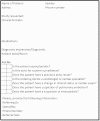How I do it: judging appropriateness for TTE and TEE
- PMID: 24961689
- PMCID: PMC4079626
- DOI: 10.1186/1476-7120-12-22
How I do it: judging appropriateness for TTE and TEE
Abstract
The increasing cost of healthcare is a widespread international problem to which the cost of imaging has been an important contributor. Some imaging tests are ordered inappropriately and contribute to wasted use of resources. Appropriate use criteria have been developed in the USA in order to guide test selection, but there are a number of problems, including the evidence base for these criteria and the steps that can be taken to change physician practice. A restrictive approach to test ordering is difficult to fit to the nuances of clinical presentation and may compromise patient care. We propose an alternative approach to physician guidance based on the most common markers of inappropriate testing.
Figures



Similar articles
-
Application of appropriateness criteria in outpatient transthoracic echocardiography.J Am Soc Echocardiogr. 2009 Jan;22(1):53-9. doi: 10.1016/j.echo.2008.10.020. J Am Soc Echocardiogr. 2009. PMID: 19131002 Free PMC article.
-
Addition of price transparency to an education and feedback intervention reduces utilization of inpatient echocardiography by resident physicians.Int J Cardiovasc Imaging. 2019 Jul;35(7):1259-1263. doi: 10.1007/s10554-019-01572-2. Epub 2019 Mar 8. Int J Cardiovasc Imaging. 2019. PMID: 30850907
-
Appropriateness vs value: Echocardiography in primary care.Clin Cardiol. 2017 Dec;40(12):1212-1217. doi: 10.1002/clc.22810. Epub 2017 Dec 16. Clin Cardiol. 2017. PMID: 29247530 Free PMC article.
-
[Transesophageal echocardiography (TEE)].Z Kardiol. 2000;89 Suppl 1:110-8. Z Kardiol. 2000. PMID: 10907309 Review. German.
-
Guideline-based decision support has a small, non-sustained effect on transthoracic echocardiography ordering frequency.BMJ Qual Saf. 2016 Jan;25(1):57-62. doi: 10.1136/bmjqs-2015-004284. Epub 2015 Sep 24. BMJ Qual Saf. 2016. PMID: 26405095 Review.
Cited by
-
Appropriate Use Criteria in Echocardiography: An Observational Institutional Study with the Perspective of a Quality Improvement Project.Clin Med Insights Cardiol. 2016 Feb 16;10:23-8. doi: 10.4137/CMC.S36504. eCollection 2016. Clin Med Insights Cardiol. 2016. PMID: 26917982 Free PMC article.
-
Low prevalence of relevant findings in inappropriate echocardiograms and discordant perceptions between cardiologists and patients.Braz J Med Biol Res. 2018;51(8):e7413. doi: 10.1590/1414-431x20187413. Epub 2018 May 28. Braz J Med Biol Res. 2018. PMID: 29846434 Free PMC article.
-
Development and validation of a screening tool for the identification of inappropriate transthoracic echocardiograms.BMJ Open. 2016 Oct 5;6(10):e012702. doi: 10.1136/bmjopen-2016-012702. BMJ Open. 2016. PMID: 27707833 Free PMC article.
References
-
- Fitch K, Bernstein S, Aguilar MD, Burnand B, La Calle JR, Lazaro P, Loo M, McDonnell J, Vader JP, Kaham JP. The RAND/UCLA Appropriateness Method user's manual. Santa Monica (CA): RAND Corporation; 2001.
-
- Hendel RC, Patel MR, Allen JM, Min JK, Shaw LJ, Wolk MJ, Douglas PS, Kramer CM, Stainback RF, Bailey SR, Doherty JU, Brindis RG. Appropriate Use of Cardiovascular Technology 2013 ACCF Appropriate Use Criteria Methodology Update: A Report of the American College of Cardiology Foundation Appropriate Use Criteria Task Force. J Am Coll Cardiol. 2013;61(12):1305–1317. doi: 10.1016/j.jacc.2013.01.025. - DOI - PubMed
-
- Carr JJ, Hendel RC, White RD, Patel MR, Wolk MJ, Bettmann MA, Douglas P, Rybicki FJ, Kramer CM, Woodard PK, Shaw LJ, Yucel EK, Writing G. Appropriate Utilization of Cardiovascular Imaging A Methodology for the Development of Joint Criteria for the Appropriate Utilization of Cardiovascular Imaging by the American College of Cardiology Foundation and American College of Radiology. J Am Coll Radiol. 2013;10(6):456–463. doi: 10.1016/j.jacr.2013.03.019. - DOI - PubMed
MeSH terms
LinkOut - more resources
Full Text Sources
Other Literature Sources
Medical

